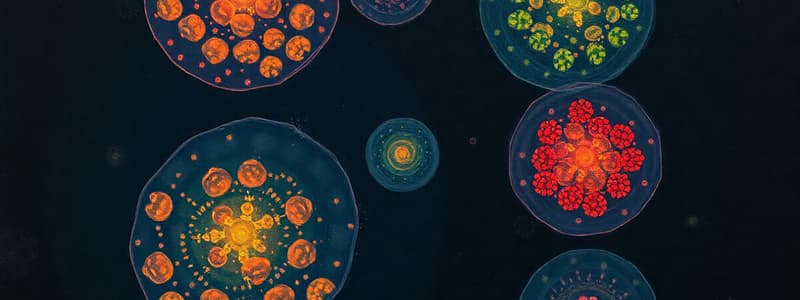Podcast
Questions and Answers
What is the primary function of topoisomerases during DNA replication?
What is the primary function of topoisomerases during DNA replication?
- They unwind DNA.
- They make nicks to resolve supercoiling. (correct)
- They bind DNA to the cell membrane.
- They synthesize RNA.
Which statement accurately describes the nucleoid's role in prokaryotic cells?
Which statement accurately describes the nucleoid's role in prokaryotic cells?
- It acts as the site for mitosis.
- It regulates growth, reproduction, and function of the cell. (correct)
- It is a membrane-bound organelle.
- It contains mitochondria for energy production.
How does supercoiling contribute to DNA organization within the nucleoid?
How does supercoiling contribute to DNA organization within the nucleoid?
- By separating DNA strands into individual units.
- By decreasing the level of compaction.
- By twisting the DNA to increase density and reduce space. (correct)
- By keeping DNA linearized and untwisted.
During which process is RNA synthesized using DNA as a template?
During which process is RNA synthesized using DNA as a template?
What is a key consequence of DNA replication for prokaryotic cells?
What is a key consequence of DNA replication for prokaryotic cells?
What happens to bacterial DNA when cell conditions change, like during growth or division?
What happens to bacterial DNA when cell conditions change, like during growth or division?
Why is RNA essential for prokaryotic cells?
Why is RNA essential for prokaryotic cells?
What distinguishes prokaryotic cells from eukaryotic cells?
What distinguishes prokaryotic cells from eukaryotic cells?
What is the role of the nucleoid region in prokaryotic cells?
What is the role of the nucleoid region in prokaryotic cells?
Why do prokaryotic cells not have a membrane-bound nucleus?
Why do prokaryotic cells not have a membrane-bound nucleus?
Which of the following statements is true about the DNA found in prokaryotic cells?
Which of the following statements is true about the DNA found in prokaryotic cells?
What role do histones play in the nucleoid region of prokaryotic cells?
What role do histones play in the nucleoid region of prokaryotic cells?
Which of the following proteins is NOT mentioned as being present in the nucleoid region?
Which of the following proteins is NOT mentioned as being present in the nucleoid region?
Which of the following is a characteristic of the nucleoid region?
Which of the following is a characteristic of the nucleoid region?
Prokaryotic DNA is generally found in what shape?
Prokaryotic DNA is generally found in what shape?
Flashcards are hidden until you start studying
Study Notes
Prokaryotic vs. Eukaryotic Cells
- All cells are either prokaryotic or eukaryotic.
- Prokaryotic cells lack membrane-bound organelles, including a nucleus.
- Eukaryotic cells possess membrane-bound organelles, including a nucleus containing most of the cell's DNA.
- DNA in prokaryotes is located in a nucleoid region, which is not membrane-bound.
The Nucleoid Region
- The nucleoid is a non-membrane-bound region in prokaryotic cells containing most or all of the cell's DNA.
- Prokaryotic DNA is circular and exists as plasmids; multiple copies may be present.
- The nucleoid's boundaries are not clearly defined, yet it's highly organized.
- The nucleoid contains DNA, RNA, proteins (including histones and topoisomerases), and enzymes.
- Histones help organize and compact DNA.
- Topoisomerases create nicks in DNA to manage supercoiling during replication and transcription.
Nucleoid Function
- The nucleoid is the prokaryotic cell's regulatory center, controlling growth, reproduction, and function.
- DNA replication (essential for binary fission) and RNA transcription (necessary for protein synthesis) occur in the nucleoid.
- DNA's association with the cell membrane ensures its segregation during cell division.
- Proteins and enzymes, while some function outside the nucleoid, all originate from it.
Nucleoid Structure
- The nucleoid's structure is undefined, but DNA is generally contained within it.
- DNA may be found outside the nucleoid under certain conditions (e.g., cell growth, division).
- Multiple DNA copies (including from other bacterial cells) can exist in the nucleoid.
- DNA compaction involves supercoiling and organization around histones. Supercoiling increases DNA compaction.
Studying That Suits You
Use AI to generate personalized quizzes and flashcards to suit your learning preferences.




